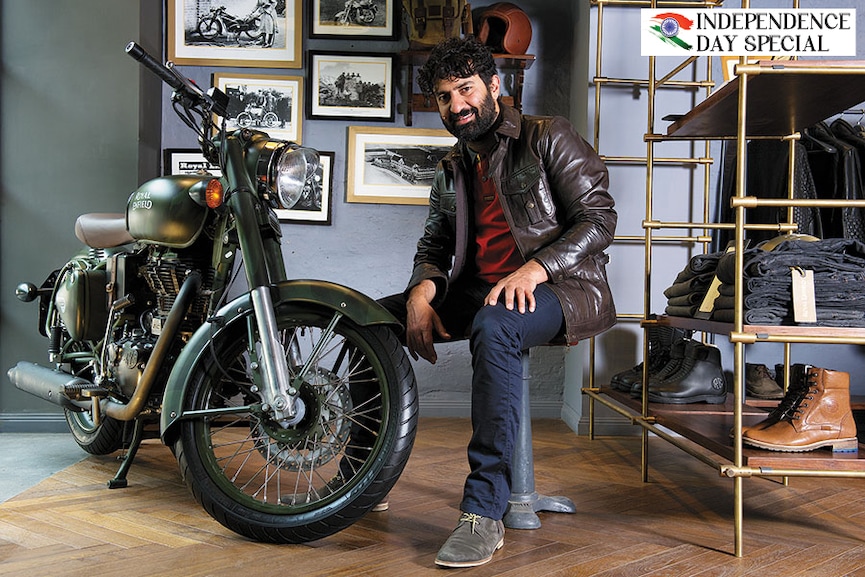 Siddhartha Lal, chief executive officer and managing director of Eicher Motors Ltd. Image: Amit Verma
Siddhartha Lal, chief executive officer and managing director of Eicher Motors Ltd. Image: Amit Verma
When India became independent, its economy was mostly agrarian, with farmers dependent on traditional, manual methods of farming. It was at a time like this when Man Mohan Lal set up Goodearth Company to import and distribute tractors in 1948. Given the precarious nature of the country’s economy, and the earnings the vast majority of farmers generated, between 1952 and 1957, the company sold 1,500 tractors in India.
Despite numbers that can look meagre in current times, in 1958, Goodearth entered a seven-year partnership with German tractor makers Eicher Traktoren to manufacture the farm vehicles in India. The company was renamed Eicher Tractor Corporation of India Limited, and became the first tractor maker of the country.
The following year, it rolled out the first indigenously built tractor from its Faridabad factory for the Indian market. In 1960, the company was renamed Eicher Tractors India Limited, and, over the next 15 years, it achieved 100 percent indigenisation of its manufacturing process. It was also during this period, in 1966, that Man Mohan Lal’s son, Vikram, joined the family business.
The 1980s saw Eicher Tractors pull off a feat that few Indian companies could even dream of in those days: Eicher Tractors India, then with a revenue of around Rs 80 crore, acquired the parent German Eicher Traktoren, which was reeling in an economy stricken by depression. Armed with loans from foreign banks, Vikram—who had studied mechanical engineering at the Technische Universität Darmstadt and had been an apprentice at Eicher Traktoren for two years—invested Rs 2 crore to rescue the parent company.
Eicher Motors Limited was incorporated in 1982, and Vikram established an assembly line in Germany with components imported from India. He aimed to export Rs 50 lakh worth of components to Germany in 1985, increasing the volume over the coming years. What Vikram achieved established not just his company’s credentials, but also that of Indian manufacturing.
The decade also saw Eicher Motors get into a collaboration with Japan’s Mitsubishi in 1982 for the manufacturing of light commercial vehicles, and Eicher Tractors going public in 1987.
In the 1990s, Eicher Goodearth bought an initial 26 percent stake in Enfield India, which was raised to 60 percent equity shareholding in 1993. The following year, the motorcycle maker’s name was changed to Royal Enfield Motors Limited. In 1996, Eicher Tractors merged with Royal Enfield to form Eicher Limited. In 1999, Vikram’s son Siddhartha joined the company, and after initially working in the tractor division he took on the task of reviving the failing fortunes of Royal Enfield.
 Sales were low—about 2,000 units a month—compared to a production capacity of 6,000, and the bike was plagued with reliability issues. The management at Eicher Motors did not see much value in the vertical, but Siddhartha asked his father for two years in which to turn the company around.
Sales were low—about 2,000 units a month—compared to a production capacity of 6,000, and the bike was plagued with reliability issues. The management at Eicher Motors did not see much value in the vertical, but Siddhartha asked his father for two years in which to turn the company around.
Even as Siddhartha effected this turnaround, Eicher Motors disinvested the businesses of tractors and engines to TAFE Motors & Tractors in 2005, and entered a partnership with Volvo Group to establish VE Commercial Vehicles Limited (VECV) in 2008 for the manufacture of commercial vehicles. Two years later, the company launched the VE-series of heavy-duty trucks.
Siddhartha continued to grow the Royal Enfield brand, by launching the Thunderbird 350 and 500 models (2012), opening its second manufacturing facility at Oragadam in Tamil Nadu, in 2013, and launching the Continental GT 535 cc café racer in the UK the same year. The following year, the brand opened its first concept store in Delhi, and its first exclusive store in London. In 2015, he acquired erstwhile collaborators, UK-based Harris Performance, and set up its first direct distribution subsidiary outside India, in North America. Royal Enfield North America is headquartered in Milwaukee, Wisconsin. By 2015, Royal Enfield was contributing 40 percent of Eicher Motors’ turnover and 80 percent of its operating profit (Ebitda).Also read: L&T and the growth of a self-dependent India after 1947
Over the next decade, Royal Enfield continued to launch new models such as the Himalayan, the Continental GT, the Interceptor and the Meteor. In 2017, the company moved into its state-of-the-art tech centre at Leicestershire, UK, to design and develop motorcycle platforms for the global market. This July, Royal Enfield launched the Guerilla 450.
For the March 2024-ended quarter, Eicher Motors recorded a total revenue of Rs 4,256 crore, up 11.87 percent as compared to Rs 3,804 crore in the corresponding quarter of FY 2022-23. Shares of Eicher Motors crossed the Rs 5,000-mark for the first time on July 26, hitting a new all-time high of Rs 5,058.90, up by 3.2 percent. This is the culmination of a steady bull run since February, during which it has grown 32 percent, outperforming the entire CY23 return of 28.4 percent in just six months.
Royal Enfield continues to dominate the premium motorcycle market in India, although its market share has dipped to 88.3 percent in FY24 from 96.3 percent in FY19. Competition has come from rivals Hero MotoCorp and Bajaj Auto, which have entered the premium category. For FY24, Royal Enfield sold 9,12,732 motorcycles, 9 percent more than the previous year; more than 77,000 units were sold in export markets.
